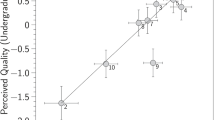Abstract
A discussion of production system approaches to the representation of learned procedures, and of stage models of the acquisition of procedures, yielded four general principles applicable to the construction of effective explanations. The intuitive appreciation of these principles by tertiary teachers was tested in two studies. In the first, separate verisons of an explanation of a standard undergraduate mathematics problem solution procedure were prepared, these versions differing in the extent to which they exemplified the derived principles. Subjects ranked the explanations in terms of their perceived effectiveness. In the second study, subjects of varying experience at teaching tertiary level mathematics were video recorded while they individually explained three standard undergraduate problems. Their explanations were scored for the extent to which some awareness of the general principles was evidenced. In general terms the findings from these two studies suggested that mathematics teachers might be well able to discriminate between explanations which differ in their compliance with the derived general principles, but that they were not well skilled at employing these principles in explanations which they generated themselves.
Similar content being viewed by others
References
Anderson, J. R. (1982). Acquisition of cognitive skill,Psychological Review 89, 369–406.
Anderson, J. R. (1987). Skill acquisition: Compilation of weak-method problem solutions,Psychological Review, 94, 192–210.
Anderson, J. R. (1990).Cognitive psychology and its implications. Third Edition. New York: Freeman.
Anderson, J. R., Conrad, F. G. and Corbett, A. T. (1989). Skill acquisition and the LISP tutor.Cognitive Science 13, 467–505.
Bovair, S., Kieras, D. E. and Polson, P. G. (1990). The acquisition and performance of text-editing skill: A cognitive complexity analysis.Human-Computer Interation 5, 1–48.
Dixon, P. (1987). Actions and procedural directions. In R. S. Tomlin (Ed.),Coherence and grounding in discourse. Amsterdam: John Benjamins. Pp. 67–89. (a)
Dixon, P. (1987). The processing of organizational and component step information in written directions.Journal of Memory and Language 26, 24–35. (b)
Dixon, P. (1987). The structure of mental plans for following directions.Journal of Experimental Psychology: Learning, Memory, and Cognition 13, 18–26. (c)
Dixon, P., Faries, J. and Gabrys, G. (1988). The role of explicit action statements in understanding and using written directions.Journal of Memory and Language 27, 649–667.
Dixon, P. and Gabrys, G. (1991). Learning to operate complex devices: Effects of conceptual and operational similarity.Human Factors 33(1), 103–120.
Duffy, G. G., Roehler, L. R., Meloth, M. S. and Vavrus, L. G. (1986). Conceptualizing instructional explanation.Teaching and Teacher Education 2, 197–214.
Gagné, R. M. and Briggs, L. J. (1988).Principles of instructional design, 3e. New York: Holt, Rinehart & Winston.
Greeno, J. G. (1978). Understanding and procedural knowledge in mathematics instruction.Educational Psychologist 12(3), 262–283.
Kieras, D. E. (1988). Towards a practical GOMS model methodogy for user interface design. In M. Helander (Ed.),Handbook of human-computer interaction. Amsterdam: Elsevier. Pp. 135–157.
Kieras, D. E. and Bovair, S. (1984). The role of a mental model in learning to operate a device.Cognitive Science 8, 255–273.
Kieras, D. E. and Bovair, S. (1986). The acquisition of procedures from text: A production-system analysis of transfer of training.Journal of Memory and Language 25, 507–524.
Kieras, D. E. and Bolson, P. G. (1985). An approach to the formal analysis of user complexity.International Journal of Man-Machine Studies 22, 365–394.
LeFevre, J. and Dixon, P. (1986). Do written instructions need examples?Cognition and Instruction 3(1), 1–30.
Leinhardt, G. and Greeno, J. G. (1986). The cognitive skill of teaching.Journal of Educational Psychology 78, 75–95.
Leinhardt, G. and Smith, D. A. (1985). Expertise in mathematics instruction: Subject matter knowledge.Journal of Educational Psychology 77, 247–271.
Martin, J. (1987). Double coding: A key to knowledge utilization and generation in the instruction and learning of skills.Instructional Science 16, 47–58.
Mayer, R. E. (1986). Mathematics. In R. F. Dillon & R. J. Sternberg (Eds.),Cognition and instruction. Orlando, FL: Academic. Pp. 127–154.
McKendree, J. (1990). Effective feedback content for tutoring complex skills.Human-Computer Interaction 5, 381–413.
Nesher, P. (1986). Learning mathematics: A cognitive perspective.American Psychologist 41, 1114–1122.
neves, D. M. and Anderson, J. R. (1981). Knowledge compilation: mechanisms for the automatization of cognitive skills. In J. R. Anderson (Ed.),Cognitive skills and their acquisition. Hilsdale, NJ: Erlbaum. Pp. 57–84.
Novak, J. D. (1990). Concept maps and Vee diagrams: Two metacognitive tools to facilitate meaningful learning.Instructional Science 19, 29–52.
Reder, L. M., Charney, D. H. and Morgan, K. I. (1986). The role of elaborations in learning a skill from an instructional text.Memory and Cognition 14, 64–78.
Woltz, D. J. (1988). An investigation of the role of working memory in procedural skill acquisition.Journal of Experimental Psychology: General 117, 319–331.
Zeitz, C. M. and Spoehr, K. T. (1989). Knowledge organization and the acquisition of procedural expertise.Applied Cognitive Psychology, 3, 313–336.
Author information
Authors and Affiliations
Rights and permissions
About this article
Cite this article
Eley, M.G., Cameron, N. Proficiency in the explanation of procedures: A test of the intuitive understanding of teachers of undergraduate mathematics. High Educ 26, 355–386 (1993). https://doi.org/10.1007/BF01383734
Issue Date:
DOI: https://doi.org/10.1007/BF01383734




